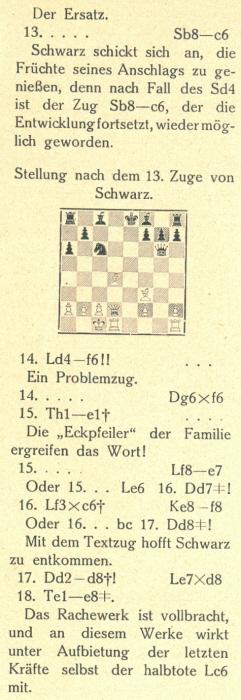Chess Explorations (50)
By Edward Winter
One of our recent explorations concerns Nimzowitsch’s famous victory against Alapin:
1 e4 e6 2 d4 d5 3 Nc3 Nf6 4 exd5 Nxd5 5 Nf3 c5 6 Nxd5 Qxd5 7 Be3 cxd4 8 Nxd4 a6 9 Be2 Qxg2 10 Bf3 Qg6 11 Qd2 e5 12 O-O-O exd4 13 Bxd4 Nc6
14 Bf6 Qxf6 15 Rhe1+ Be7 16 Bxc6+ Kf8 17 Qd8+ Bxd8 18 Re8 mate.
The topic was raised in C.N. 6784 by Maurice Carter (Fairborn, OH, USA), who expressed surprise at the varying information printed about the occasion:
- My System (London, 1929 – at the start of the ‘Illustrative Games’ section): no location or date;
- My System (London, 1950): Carlsbad, 1911;
- My System (Philadelphia, 1947 – edited by F. Reinfeld): Riga, 1913;
- My System (Dallas, 1991 – edited by L. Hays): Carlsbad, 1911;
- Alt om Skak by B. Nielsen (Odense, 1943): St Petersburg, 1913;
- Aron Nimzowitsch by B. Nielsen (Aabybro, 1945): St Petersburg, 1913;
- Nimzovich the hypermodern by F. Reinfeld (Philadelphia, 1948): Riga, 1913;
- Aaron Nimzowitsch by G.H. Marten (Hamburg, 1995): Vilnius, 1912.
As regards contemporary publications, Mr Carter pointed out the following on page 298 of The Year-Book of Chess 1914 edited by M.W. Stevens (London, 1915):

And from page 63 of volume one of Schachjahrbuch 1914 by L. Bachmann (Ansbach, 1914):

We added that page 206 of the July 1914 Deutsche Schachzeitung reproduced the same notes to the game, ‘welche nach Beendigung des allrussischen Meisterturniers als freie Partie in St. Petersburg gespielt worden ist’. A question asked, and not yet answered, is whether the Riga publication specifically stated that the miniature was an informal game played after the end of the All-Russian Masters’ Tournament in St Petersburg. That event took place from 4 to 31 January 1914 (new style), and it would be curious indeed to find that the Nimzowitsch v Alapin game was thus played in St Petersburg in 1914, an option not mentioned in any of the books listed by Mr Carter.
The original edition of Mein System (Berlin, 1925) gave no venue or date for the game. Nor did the Russian edition (Moscow, 1930). The algebraic version of My System produced by Quality Chess Europe AB (Göteborg, 2007) put Vilnius, 1912. The original English-language translator of My System, Philip Hereford, co-authored with W.H. Watts Every Game Check Mate (London, 1932), and the Nimzowitsch v Alapin game appeared on page 85 (‘Carlsbad, 1911’). On page 164 of 200 Miniature Games of Chess (London, 1941) J. du Mont gave the date as 1915, without specifying any location.

Aron Nimzowitsch
A further question arises from Irving Chernev’s publication of the game in 1000 Best Short Games of Chess and The Chess Companion (pages 262-263 and 242 respectively). Both times he put ‘Riga, 1913’ and stated that Nimzowitsch had called the game ‘The Pride of the Family’. We asked in C.N. 6784 where that description originated.
In C.N. 6789 Javier Asturiano Molina (Murcia, Spain) noted that the ‘Pride of the Family’ phrase appeared when Nimzowitsch presented the game, with a different set of notes, on pages 160-161 of the 1 April 1925 issue of Kagans Neueste Schachnachrichten:


This prompted us to suggest that Chernev was incorrect (e.g. on page 242 of The Chess Companion, reproduced below) to interpret the ‘Pride of the Family’ remark as an indication by Nimzowitsch that it was his favourite game:

As shown above (Kagans Neueste Schachnachrichten), in his note to White’s eighth move Nimzowitsch described the knight on d4 as the pride of the (white) family. We thus read his heading to the game as a mere reflection of that annotational remark, and not as a description of the game itself.

Simon Alapin
The question of where and when the game was played remains unresolved. In C.N. 6799 Vitaliy Yurchenko (Uhta, Komi, Russian Federation) mentioned that ‘St Petersburg, 1914’ was given as the occasion in the 1974 and 1984 Russian editions of Nimzowitsch’s My System, whereas in C.N. 6822 Jens Askgaard (Fakse, Denmark) provided another, more specific, date for the game. The Danish translation of My System (1976) had this description: ‘Frit parti, spillet i St. Petersburg maj 1914’ (Casual game, played in St Petersburg, May 1914).
Also by Edward Winter:
Submit information or suggestions on chess explorations
All ChessBase articles by Edward Winter
 Edward Winter is the editor of Chess Notes, which was founded in January 1982 as "a forum for aficionados to discuss all matters relating to the Royal Pastime". Since then, over 6,830 items have been published, and the series has resulted in four books by Winter: Chess Explorations (1996), Kings, Commoners and Knaves (1999), A Chess Omnibus (2003) and Chess Facts and Fables (2006). He is also the author of a monograph on Capablanca (1989).
Edward Winter is the editor of Chess Notes, which was founded in January 1982 as "a forum for aficionados to discuss all matters relating to the Royal Pastime". Since then, over 6,830 items have been published, and the series has resulted in four books by Winter: Chess Explorations (1996), Kings, Commoners and Knaves (1999), A Chess Omnibus (2003) and Chess Facts and Fables (2006). He is also the author of a monograph on Capablanca (1989).
Chess Notes is well known for its historical research, and anyone browsing in its archives will find a wealth of unknown games, accounts of historical mysteries, quotes and quips, and other material of every kind imaginable. Correspondents from around the world contribute items, and they include not only "ordinary readers" but also some eminent historians – and, indeed, some eminent masters. Chess Notes is located at the Chess History Center. Signed copies of Edward Winter's publications are currently available.


























 Edward Winter is the editor of
Edward Winter is the editor of 




